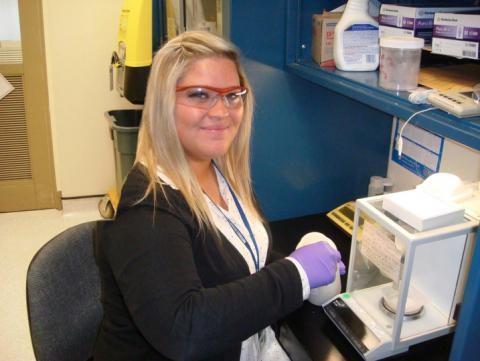
Undergraduate student cooks up ways to lighten the U.S. power load
By Michelle La Vone
Sprawled across the ceilings of buildings nationwide are fluorescent tubes flooding the floors with light. The U.S. Energy Information Administration estimates that fluorescent lights only use 25 to 35 percent of the energy used by incandescent lights, and they last 10 times longer.
To keep America bright, Shelby Stooksbury and others in the Materials Science and Technology Division at Oak Ridge National Laboratory hope to find new phosphors—substances that give off light after being energized—that yield high energy efficiency and long lifetimes. They hope to do this without employing critical materials like the europium element presently used in the red phosphor in fluorescent tubes.
Stooksbury is a third-year participant in the Higher Education Research Experiences (HERE) program at ORNL. The HERE program is administered by ORAU through its contract with the U.S. Department of Energy (DOE) to manage the Oak Ridge Institute for Science and Education. The program is open to faculty and students of various academic levels and is intended to provide a one-of-a-kind, hands-on learning experience in a world-class federal laboratory setting.
Her research is part of a nationwide effort directed by the DOE-supported Critical Materials Institute (CMI) that is headquartered at Ames Laboratory in Ames, Iowa. The CMI concentrates on new technologies that reduce the dependence of the U.S. on vital materials subject to global supply disruptions.
The overall goal of Stooksbury’s research is to identify new red phosphors that require a low input of energy but give off a high intensity of light. In a fluorescent lighting tube where mercury vapor subjected to an electric current generates UV light, which then strikes a phosphor coating.
The team is working to develop a red phosphor that does not use any rare-earth elements—critical materials that, when in short supply, can significantly increase the cost of fluorescent lighting. Rare-earth materials represent a distinct group of naturally occurring elements.
“I tell my friends and family that contributing to this phosphor project makes me seem like a scientific cook,” said Stooksbury. “I mix up certain chemicals, carefully weigh out the recipe, and place the chemicals in the appropriate ‘pan’ or crucible for baking. Then, I put them in an oven and let them cook…just like baking a cake!”
And, just like baking a cake, Stooksbury sometimes finds the end result is less than ideal. That’s the fun of it, she said—trial and error.
“Whenever something doesn’t work, my group will figure out the problem or try something new, and this is always exciting. When an idea does finally work, it is a wonderful, greatly rewarding feeling.”
Under the direction of Lynn Boatner, Ph.D., and James Kolopus in the ORNL Synthesis and Properties of Novel Materials Group, Stooksbury has contributed research that has earned her a mention (under her maiden name, Brackett) in two published scientific papers in the journals Applied Physics Letters and SPIE Proceedings.
She has also garnered numerous laboratory skills that will help her in her intended career as a laboratory scientist, including novel ways to think about the problems and solutions inherent in research.
By communicating with top-level scientists and seeing first-hand the plethora of ideas and labor needed to successfully run a project, Stooksbury has gained a new appreciation for science and technology as well as everyone involved.
“Machinists, electricians, glass shop workers, people that test the final product with specialized equipment—it takes many hands and heads to make research successful, and being in this program makes you appreciate and realize that,” she said.
Stooksbury definitely recommends the program to others, especially freshmen or sophomores. She first participated in the HERE program the summer after her sophomore year at East Tennessee State University, where she is pursuing a bachelor’s degree in health science with a concentration in microbiology.
“The longer that you are able to be here and research with top scientists, the better off you will be,” she said. “Do not be intimidated, because everyone here is glad you are here and willing to help you in any way. This is something that you will definitely not regret. My time here has been nothing but wonderful, and the HERE program in particular has been one of the greatest experiences of my life.”
